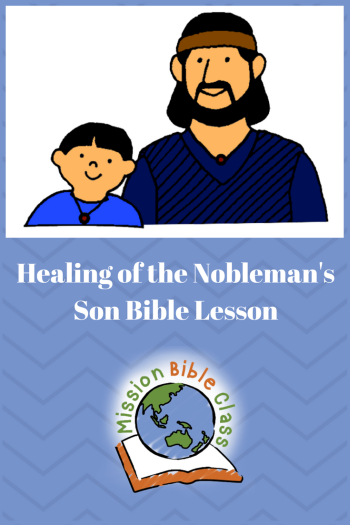 Scripture Reference:
Scripture Reference:
John 4:46-54
Suggested Emphasis:
Believe the words of Jesus.
Memory Verse: “Jesus did many other miracles before his followers that are not written in this book. But these are written so that you can believe that Jesus is the Christ, the Son of God. Then, by believing, you can have life through his name.” John 20:30-31, ICB
Story Overview:
While Jesus was preaching in Galilee a nobleman (royal official) from the city of Capernaum approached and begged Jesus to come heal his dying son. Instead of going to Capernaum, Jesus told the nobleman to go back home. His son would live. The nobleman “took Jesus at his word” and returned home to find his son well. The fever had gone at the same hour Jesus had said he would live.
Background Study:
(John 4:39-41). Jesus has been travelling and preaching the word of God. Originally he had performed his first miracle in the town of Cana in the region of Galilee. In today’s story, he returns to Cana after travelling around Samaria.
Jesus notices that the people in Galilee are different than in Samaria. He had not performed any miracles in Samaria yet many had believed. The people in Galilee seemed to demand miracles before they would believe.
The nobleman in today’s story was probably a royal official in Herod Antipas’ court. This was the son of the Herod that was king of the Jews when Jesus was born.
The man had travelled all the way from Capernaum to see Jesus (verse 46). This would have been over 25 kilometres (about 15 miles). This speaks of the man’s love for his son as well as his faith in Jesus’ power. When Jesus talked about the people of Galilee not believing without signs and miracles, he was most probably speaking to the crowd around him. This man’s belief is obvious.
The royal official would have expected Jesus to go with him and heal his son in person. Yet, Jesus told him that his son was now healed. These were not just empty words. The official accepted this and went back home. To say that he “took Jesus at his word” shows an intense trust (verse 50). He had travelled too far to turn back unless he really believed that what Jesus said was true.
Before reaching home he received the message that his son was well. He found out the exact hour that the boy was healed. This was the same hour that Jesus had said he was healed.
The truly incredible part of this story is not only the fact that Jesus healed the boy but that he did it from 25 kilometres away. Do we take Jesus at his word?
Way to Introduce the Story:
Use a map of your area to find a town or landmark just over 25 kilometres away. Talk about walking that distance. Discuss situations where you might have to walk that far (if you were lost and did not have a car or telephone). In New Testament times people did not have cars to drive. A man in today’s story walked that far. How long do you think it took him?
top
The Story:
The son of a royal official was sick with a fever. Even though the young man’s father was a very important man there was nothing that could be done to make his son well. The son was so sick he was going to die.
The father was worried about his son and he needed to find someone to help him. Maybe the teacher, Jesus, could help. People were saying that Jesus was traveling from city to city teaching people about God and performing miracles. Some said that Jesus could even make sick people well.
That is when the royal official heard that Jesus was in the city of Cana. The boy and his father lived in the city of Capernaum by the Sea of Galilee so it would take all day to walk to Cana. But this was so important that the distance did not matter to the father. He set out right away so that he could go and get Jesus. If Jesus came to his house he could make the boy well again.
So the father travelled all the way to Cana to find Jesus. The was a royal official so he was used to giving orders and telling other people what to do. But when the royal official came to Jesus he did not give Jesus orders. Instead, he begged Jesus to travel to Capernaum with him to heal his son.
Even though Jesus could make people well he knew the most important thing was that they listen to the words he was saying about God. “Do I have to do miracles for you to believe my words?” he asked.
But all the man could think about was his son.” Please! You must travel with me to Capernaum and come to my house before my son dies!”
But Jesus did not go to the man’s house. He surprised the royal official by telling him to go back home. “Your son will live.” When Jesus said this the man DID believe his words. He immediately set off for Capernaum. It was one o’clock in the afternoon when Jesus said these words.
On the way back to his home the man’s servants met him on the road. “Your son is alive,” they exclaimed, “His fever went away!” The father was so happy to hear this good news.
“I have a question for all of you. What time did the fever go away?”
What time do you think the servants said? They said, “The fever went away at one o’clock in the afternoon.”
One o’clock in the afternoon was the exact time that Jesus had said the words, “Your son will live.” The royal official and everyone in his house now believed that Jesus’ words were always true.
Jesus had said the words when he was in Cana and the son was far away in Capernaum. Jesus made the boy well even though he was far away.
Do you know someone who is far away from you? Jesus cares about them too. Jesus’ words are important for people no matter how far away they are.
Ways to Tell the Story:
This story can be told using a variety of methods. Always remain true to the facts found in the Bible but help children connect to its meaning by using drama, visual aids, voice inflection, student interaction and/or emotion.
Click here for visual aids and story-telling methods.
Click here to download the slideshow or click here to download the pictures to print.
Be selective. Each teacher is unique so only use the illustrations that best relate to the way YOU are telling the story in THIS lesson. Too many illustrations can be confusing so eliminate any that cover other stories or details you do not wish to emphasise in this lesson.
Review Questions:
- Why did the nobleman want to see Jesus? To get Jesus to heal his dying son.
- Instead of going with the nobleman, what did Jesus say to him? Go, your son will live.
- When the man arrived back home what did he find out about his son? His son was healed at the very hour that Jesus had said he was.
Song Suggestions:
- Yes! Jesus Loves Me
- One, Two, Three Jesus Loves Me Song
- Jesus’ Love is a-Bubblin’ Over Song
- Refer to the Song Page on this website for more options.
Learning Activities and Crafts:
(How to choose the best learning activities for my teaching situation)
Activities:
- Some bibles show all of the words of Jesus in red ink. If you can locate one then bring it to class to show the children. Download a red letter version of John 4:46-54.
- Write today’s memory verse on a large piece of paper. Have the children say it with you a few times. Have one of the children tear off one part of the paper (their choice which part). Now say the verse together again filling in the part that is torn off. Keep letting the children tear off pieces until you can say the verse without any written words. (This is a long verse. If it gets too hard just put the pieces back together and start again next week).
- Write the letters B-E-L-I-E-V-E on the chalk/white board or a paper. Ask the children to list things about Jesus under each letter. Example: B-best friend E-eternal, etc.
- Make a bulletin board with the name J-E-S-U-S written in big letters in the middle. You might also want to have a nice picture of Jesus. Each week add words and timeline pictures that depict the life of Jesus.
Crafts:
- Have children draw the scenes of the story in cartoon form.
- Masking tape art project. Mask the letters B-E-L-I-E-V-E and then let the kids paint. Write the memory verse in permanent marker in the corner. Thanks to Linda Z. for this idea! Hint: After painting, carefully peel the tape away leaving the word “BELIEVE” without paint.
- Find or draw a map of your area (this can be local to your town or cover a larger geographical area). Point out your location and then find locations of other loved ones. This might be grandparents or cousins or even missionaries. Talk about how God can take care of people we know even if they are very far away from us.
- Older children can trace a simple map of Palestine (use an atlas or maps in the back of your bible). Each week this term locate and mark where the story takes place.
 Print bookmarks, trading cards or timelines (printable pages).
Print bookmarks, trading cards or timelines (printable pages).- Visit the Teaching Ideas page for additional activities and crafts.
Other Online Resources:
- Colouring page and worksheets about Jesus healing the nobleman’s son (Calvary Curriculum)
- Colouring page (Super coloring)
- Activity: Bee themed lesson with activities to teach how to “bee” like Jesus. These printables were created to study the Book of Romans but could be adapted to today’s lesson on listening to Jesus. (Kids Bible Deb Jackson)
- Online,A fun clickable map (Geology)
- Biblegateway allows you to select a “red letter” option for reading bible verses. Use this to print out scriptures for the children. (Bible gateway)
https://www.pinterest.com/marynnz/jesus-healings/
top
 ©Mission Bible Class 2011-2024 Copies may only be made for personal and ministry purposes. Not to be sold or profited from in any way. www.missionbibleclass.org
©Mission Bible Class 2011-2024 Copies may only be made for personal and ministry purposes. Not to be sold or profited from in any way. www.missionbibleclass.org










